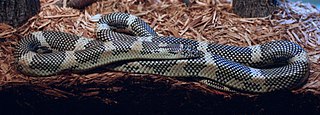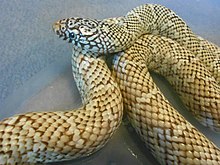
Lampropeltis triangulum, commonly known as the milk snake or milksnake, is a species of kingsnake; 24 subspecies are currently recognized. Lampropeltis elapsoides, the scarlet kingsnake, was formerly classified as a 25th subspecies, but is now recognized as a distinct species. The subspecies have strikingly different appearances, and many of them have their own common names. Some authorities suggest that this species could be split into several separate species. They are not venomous to humans.

Kingsnakes are colubrid New World members of the genus Lampropeltis, which includes 26 species. Among these, about 45 subspecies are recognized. They are nonvenomous and ophiophagous in diet.

The California kingsnake is a nonvenomous colubrid snake endemic to the western United States and northern Mexico, and is found in a variety of habitats. Due to ease of care and a wide range of color variations, the California kingsnake is one of the most popular snakes in captivity.

The desert kingsnake is a species of kingsnake native to Texas, Arizona, and New Mexico, United States. It is not venomous, colored yellow and black. The desert kingsnake's diet consists of rodents, lizards, and smaller snakes, including rattlesnakes. They normally grow 3–4 ft long, but have been known to grow up to 6.8 ft. They are docile creatures when confronted by humans. If they do not try to escape, often they "play dead" by flipping over onto their backs and lying motionless. Some who domesticate kingsnakes, such as ranchers, do so in the hopes that the kingsnakes will feed on other snakes, which might present more of a threat. It was previously considered a subspecies of the common kingsnake. The Desert Kingsnake belongs to the Colubridae family, which is the largest family of snakes in the world.

The speckled kingsnake is a nonvenomous species of kingsnake endemic to the United States.
Frank Nelson Blanchard was an American herpetologist, and professor of zoology at the University of Michigan from which institution he received his Ph.D. He is credited with describing several new subspecies, including the broad-banded water snake, Nerodia fasciata confluens, and the Florida king snake, Lampropeltis getula floridana. As well, he has been honored by having reptiles and amphibians named after him, including the western smooth green snake, ecies | Opheodrys vernalis blanchardi, and Blanchard's cricket frog, Acris crepitans blanchardi.

The Mexican black kingsnake is part of the larger colubrid family of snakes, and a subspecies of the common kingsnake, which is debated by herpetologists to contain as many as 10 unique varieties. This species occupy rocky areas and places lush with vegetation in various regions of the Sonoran Desert, Northwestern Sinaloa, Mexico, and small parts of Arizona.

Nelson's milksnake is a subspecies of king snake that is found in Mexico from southern Guanajuato and central Jalisco to the Pacific Coast. It is also found on the narrow plains of northwestern Michoacán and on the Tres Marias Islands. The range of this snake appears to be tied to the proximity of watercourses, including ones utilized for irrigation and agriculture. It is a subspecies of the milksnake, Lampropeltis triangulum. It is similar in size to other king snakes, averaging 42 inches (110 cm) long, and like them, it is nonvenomous.
Rattlesnake pilot may refer to:
Thunder snake may refer to:
Kenneth Lee Williams was an American herpetologist and author of books on the subject of snake biology and classification. Williams retired from teaching in Northwestern State University's biology department and received emeritus status in 2001. Williams is considered an authority on the milk snake and the herpetology of the Honduran Cloud Forest.

Lampropeltis getula, commonly known as the eastern kingsnake, common kingsnake, or chain kingsnake, is a harmless colubrid species endemic to the United States and Mexico. It has long been a favorite among collectors. Nine subspecies are currently recognized, including the nominate subspecies described here.

The Apalachicola kingsnake is a species of nonvenomous colubrid snake found in a small area of the Florida Panhandle known as the Apalachicola Lowlands. Long argued as to whether or not it is a subspecies, the Apalachicola kingsnake was formerly named Lampropeltis getula goini. After years of research and many more specimens examined, in 2006, it was renamed to L. g. meansi after D. Bruce Means, in recognition of his work on this subspecies.

Brooks's dyak fruit bat is a species of megabat in the family Pteropodidae endemic to Sumatra. It was formerly included as a subspecies of the dayak fruit bat. It is named for Cecil Joslin Brooks, who collected the type specimen near Bencoolen and presented it to Oldfield Thomas.
T. arenarius may refer to:

Lampropeltis getula floridana or the Florida kingsnake is a snake species native to southern Florida. On average, they grow between 3.5–5 ft but 6 ft individuals have been recorded.

Lampropeltis nigra, commonly known as the black kingsnake, is a species of nonvenomous colubrid snake indigenous to the United States. It is a species of kingsnake.












